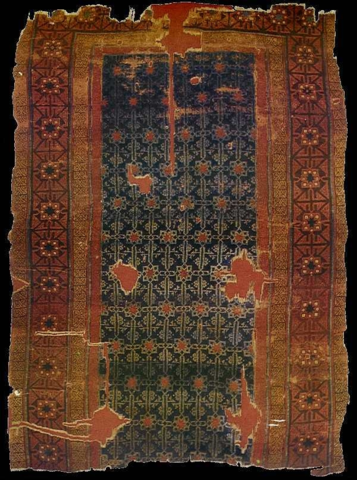Tips for Restoring an Antique Persian Rug
Over time, rugs will show signs of use and wear. Foot traffic, moisture, moths, spills, and other assaults on the rug eventually take their toll, especially if the rug is an antique.
Fortunately, if there is damage to the rug, you can take steps to repair or restore it. What you decide to do will depend on the damage to the rug and the cost and whether the rug’s value outweighs this cost. Here are a few things to know about restoring or repairing your older Persian rug.
Repairing vs Restoring.
These are not the same. Restoring is the more expensive procedure, one that attempts to most closely reproduce the original material, weave, and color of the rug. A repair does not attempt to mimic the original as closely. It is simply designed to maintain the general integrity of the rug so that it can continue to be used, as, for example, applying a patch to the rug.

A 13th-century Seljuk carpet fragment.
If you have a very high-quality, high-value piece, you may want to seriously consider a restoration. At the very least, if you get a patch, you need to make sure that the glue used will not diminish the value of the rug or preclude the possibility of restoration at some later time.
When a repair is needed
You can tell your rug needs a repair if you notice knots falling from the fringe ends or if you notice bald areas. You also want to check your rug regularly for deterioration caused by moths, noticeable by little pits in the rug, and also the presence of moth larvae, which look like fuzz or sandy lint.
You also want to keep an eye on how the rug is wearing due to foot traffic. Some areas may be showing wear more than others.
Is a restoration worth the cost?
This depends on several factors. If the value of your piece is a lot greater than the cost of the restoration, it would generally be a good idea to have restoration work done. However, if the value of the rug is only marginally higher than the cost of the restoration, or even less, you may want to forego restoration (and perhaps just have some repair work performed).
How is restoration done?
Restoration is performed by a skilled weaver who starts by splicing new threads into the rug’s pattern. He or she carefully chooses the yarns to match the original threads as closely as possible. The artist then weaves the pile with the kind of knot originally used, repeating the same pattern as the original.
Restoration is usually costly because of the time and effort involved and because few people have the skill to perform the delicate and time-consuming work.
Persian Rug Cleaner of Dallas has the expertise to restore antique and newer Persian and Oriental rugs. Give us a call at 972-447-9600 for more information.
Image by Cllane4 – Own work, CC BY-SA 3.0.

